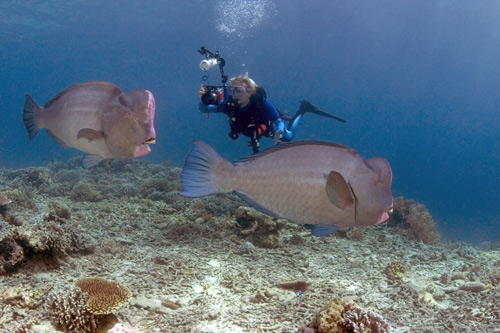‘Regular’ critters important to reefs

By Jean-Michel Cousteau
If you’ve ever walked along a pristine, white sand beach in the tropics you most likely have a parrotfish to thank for that experience. Many species of this fish, of which there are about 80, make their home in the busy ‘urban’ world of tropical coral reefs. They’re classified under a subcategory of wrasse called Scaridae and take their name from the unique structure of their teeth, which are fused together to resemble a parrot’s beak. They use these specialized teeth to scrape and bite into coral and rock to obtain the tasty algae that reside within the substrate. They are the important lawnmowers of the coral reefs, grazing and keeping the weeds in check and balance. The hard coral and rock pieces they bite off are ground up by their specialized teeth and also by special bones in the throat. In so doing, these animals play a vital role in the coral reef ecosystem by grinding up dead coral and scraping algae from rocks to clear the way for new coral polyps to attach and grow. So why, you may ask, would a parrotfish have anything to do with that sandy beach caressing your bare feet?
As parrotfish take in and grind up rocks and coral to extract the algae, they pass undigested granules out their other end. So, yes, that lovely beach is parrotfish poop! A single adult parrotfish may produce up to 2,200 pounds – one metric ton – of sand per year! These incredible animals are responsible for contributing to the beautiful beaches and sandy ocean floors all around the world.
But there’s more! Parrotfish are also fascinating in terms of their various life stages. Some species may have offspring born male and female, but most species of parrotfish are born only as females. This is referred to as protogynous hermaphroditism, a fancy term for animals that are born female and then change sex, based on either internal or environmental factors, and become males later in their lives. Following their juvenile stage, parrotfish enter an “initial phase” of adulthood where they may become a male or female. A parrotfish born male is referred to as a primary male, and will never become a dominant male. Parrotfish born female may either stay an “initial phase” female or become a male and enter a “terminal phase.” These “terminal males,” or “super-males” are larger, brighter, and may have a harem of females. If a super-male dies, the largest female will become the new dominant male. The ability of parrotfish to change gender is advantageous because it ensures that a male will always be present to fertilize the next generation of offspring.
Sea Cucumbers
Sea cucumbers are fascinating creatures. Despite their soft bodies and worm-like appearance, they are actually echinoderms, a phylum of organisms that include sea stars, sea urchins, and sand dollars. Although their adult form does not resemble these other species, sea cucumbers share many characteristics with their echinoderm relatives. Just like sea stars and sea urchins, nearly all sea cucumber species possess tube feet, which are tubular projections found on the undersides of their body. These tube feet are used for locomotion, feeding, respiration, and adhering to different substrates such as the sea floor.
Sea cucumbers also have a very interesting and complex body structure that allows them to be very flexible and versatile in the water. Their skin contains a material called “catch collagen,” which allows them to change their shape from a tightly bound ball to a loose and flaccid blob without damaging any tissue. This interesting trait allows them to squeeze through tight spaces by essentially “liquefying” their body and then re-hooking collagen fibers to become rigid again.
As for feeding, sea cucumbers are generally scavengers, feeding on dead or decaying matter, although some species are active filter feeders. They play a very important role in the recycling of nutrients throughout the world’s oceans and make up approximately 90 per cent of all the biomass found in the deep sea. They are the sanitary engineers of the different marine ecosystems, vacuuming up organic matter, extracting the nutrients and then pooping out clean sediment. There is no waste in these underwater cities we call reefs and sea cucumbers are one of many important animals that make up the cleaning crew of these bustling communities beneath the sea.
Coral reefs are marvelous underwater cities; running on solar energy, reusing and recycling valuable resources and producing no pollution or waste. They boast the highest diversity of species living together, some cooperating, some competing, some making sand, some working hard as sanitary engineers; all contributing to the stability of this aquatic urban world. But today, coral reefs are the most threatened marine ecosystem with over 25 per centdead in just the last 25 years. As divers, you are the ambassadors of the undersea world, sharing with your family and friends the experiences you have exploring these undersea gardens of coral. Your mission, if you choose to accept it, is to inspire everyone in your circle of influence to learn all that they can to live in harmony with and to protect our blue planet.
Leave a Comment







